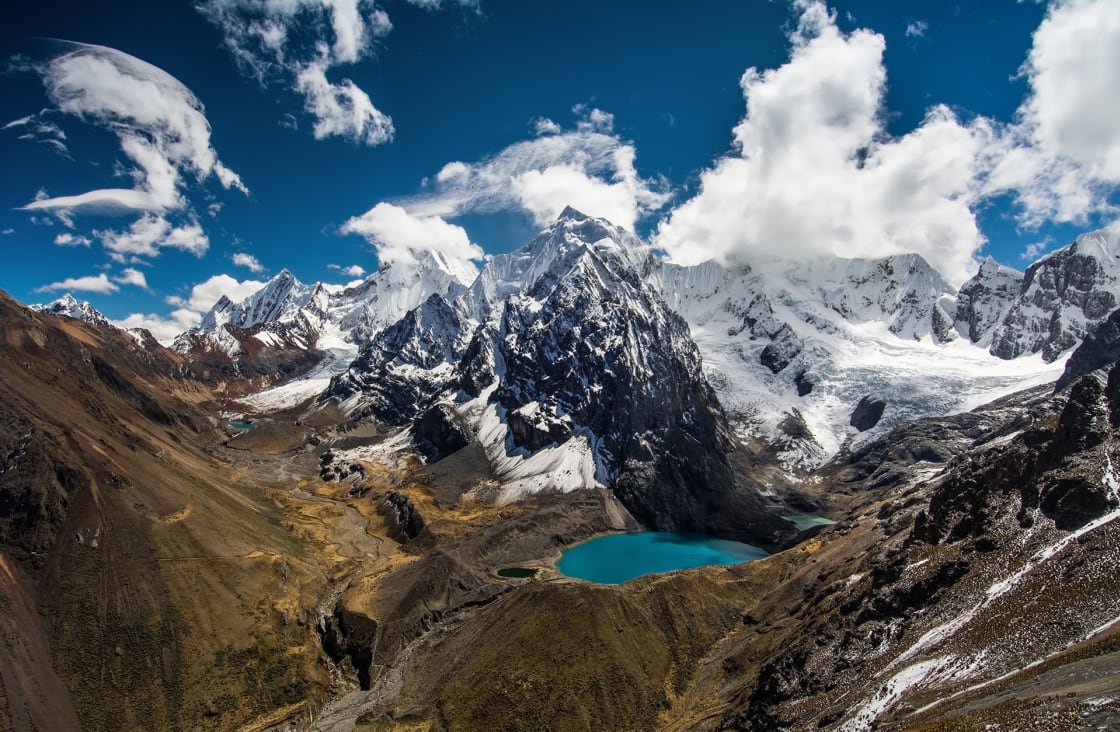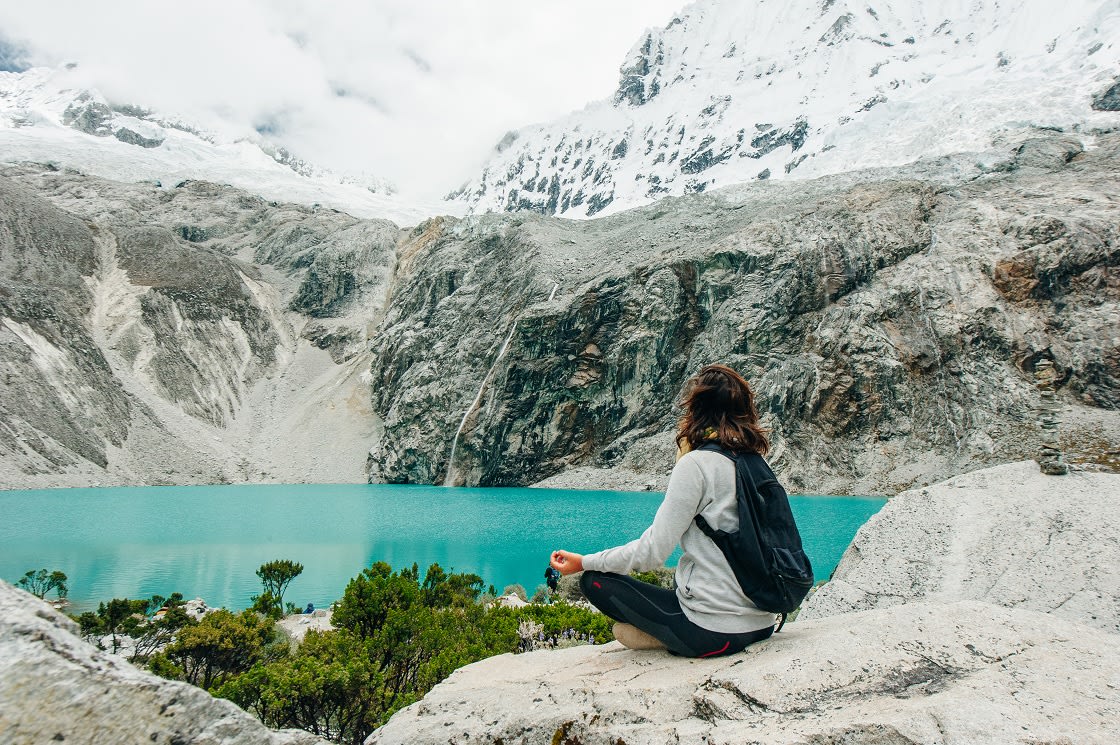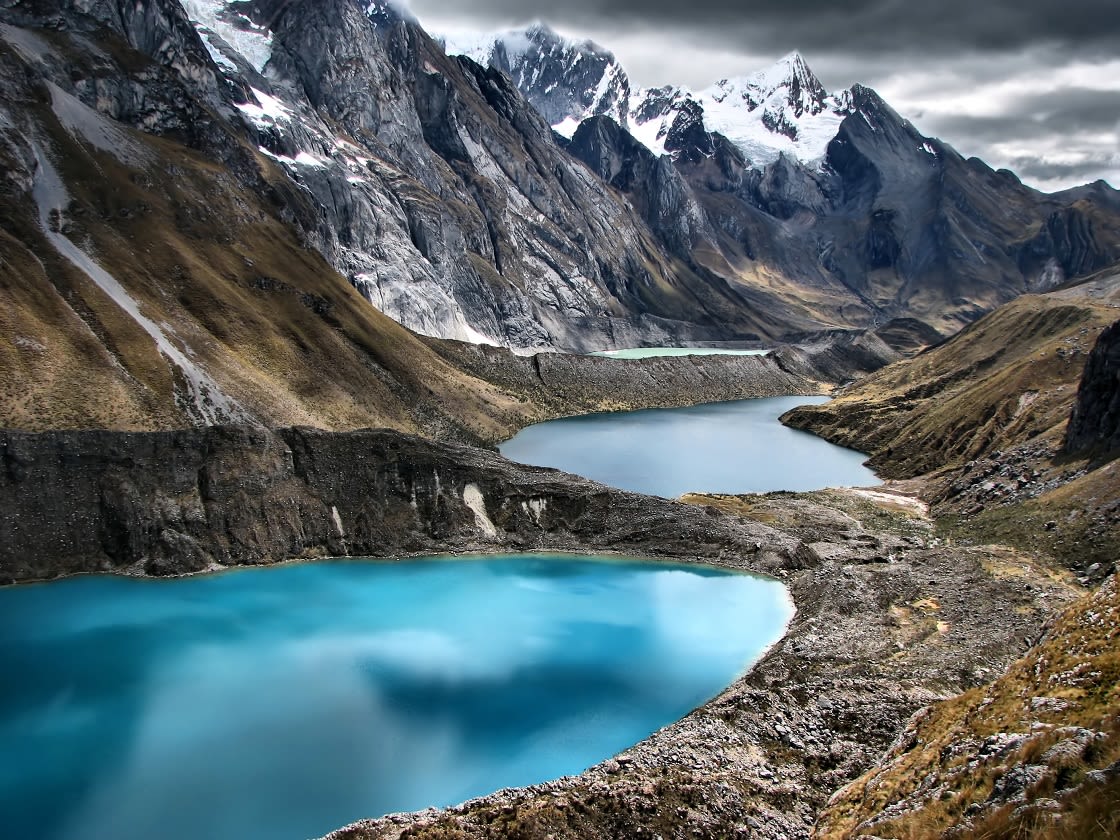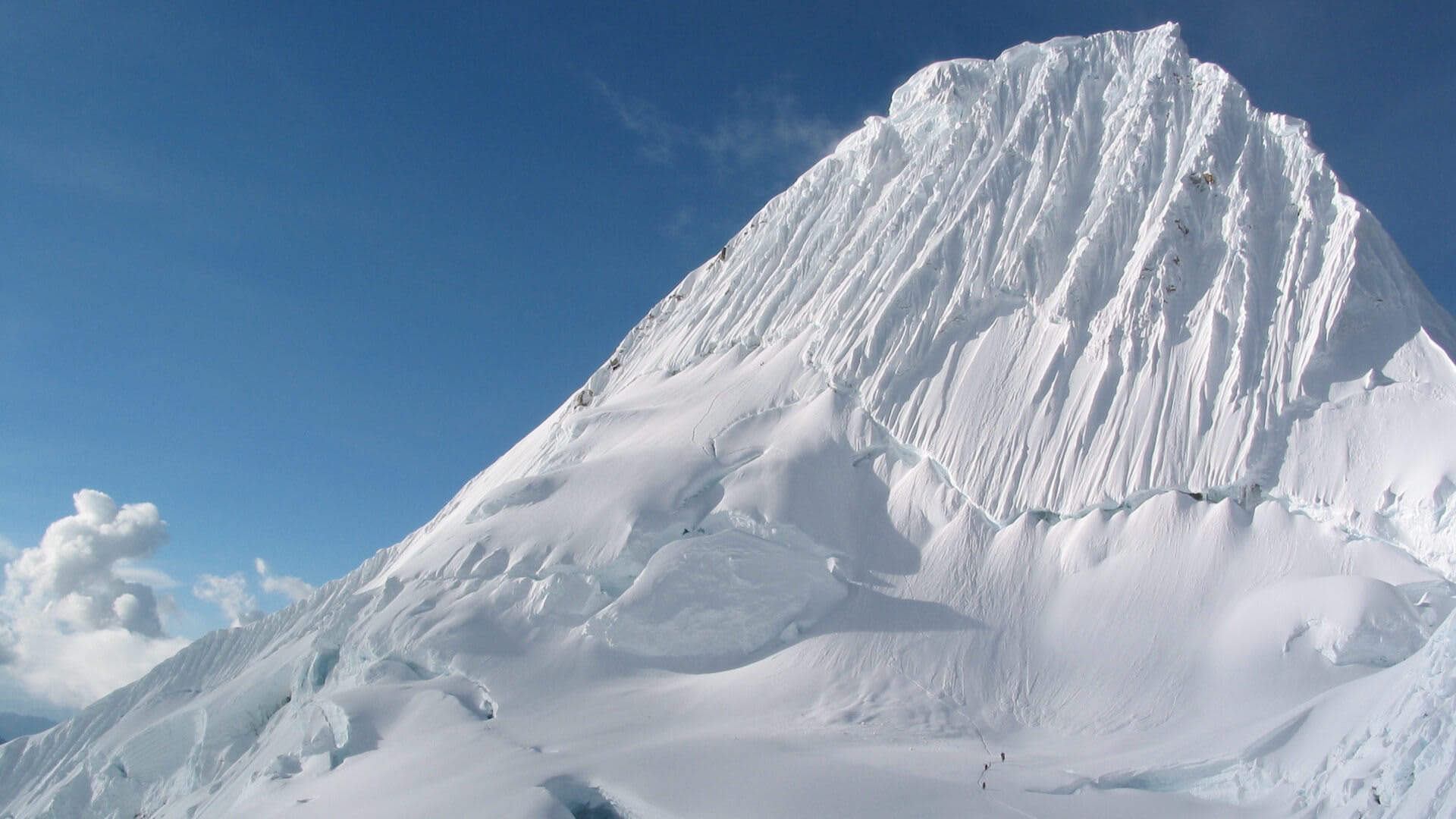
The gateway to Peru’s most spectacular hiking routes, Huaraz is a small Andean city found at the foot of the almighty Cordillera Blanca. Snow-capped peaks and crystalline glacial lakes entice the keenest of backpackers and hikers to this lesser-known Peruvian town.
Often passed over for the photogenic city of Cusco (famous for Machu Picchu and Rainbow Mountain), Huaraz is in fact much closer to Lima and an alternative, less crowded destination for committed adventurers and mountaineers. While its cityscape might lack the beauty or charm of its neighboring settlements (95% of the city was destroyed in an earthquake in 1970), if you love the great outdoors there is surely no better equivalent to this epicenter of adventure.
Huaraz sits at a very high altitude of 3,052m, amid the breathtaking glaciers of one of the world’s most impressive mountain ranges – the Cordillera Blanca in the Peruvian Andes. It’s home to the tallest mountain in Peru (and the fourth highest in South America), Huascarán Mountain in Huascarán National Park. The Cordillera Blanca is the largest tropical ice-capped mountain range in the world, reaching over 6000 meters (19,685 ft) in height. The city of Huaraz is home to around 118000 people, and is found about 250 miles (400km) from Lima.

Trekking In Cordillera Huayhuash, Peru
Huaraz is doubtlessly the hiking capital of Peru! Whether you’re a first-time hiker or an experienced mountaineer, there are hikes of all lengths and difficulties accessible from just outside the city – each with staggering scenery. Laguna 69 is a popular day trek, or you could opt for the heavier-duty Santa Cruz trek, or multi-day hikes through Cordillera Huayhuash and the Quilcayhuanca and Cojup Valleys. Here’s a rundown of 5 of the best.

Hiking To The Snow-Capped Peaks Of Laguna Churup
Churup is a good, less-crowded alternative to the Laguna 69 walk – which can get a bit over-populated. It’s a similar length and is an easy one to do without a guide in a one-day trip. Perhaps not one for total beginners as you do need to a bit of scrambling to get past a waterfall at one point! Worth bringing a warm jacket for this as it can be chilly near the lake itself.

Santa Cruz Trek, Huascaran National Park
This is for the more hardcore walkers, at around 31 miles (over trickier terrain at a high altitude). The Santa Cruz Valley circuit normally takes hikers four days and three nights – you’ll need to bring camping equipment, which you can hire in Huaraz. You can opt for a guide but it’s a fairly straightforward route to tackle solo. Prepare yourself for vast mountain passes, alpine lakes and a crystal clear view of the stars at night.

Laguna 69
The hike to Laguna 69 is probably one of the most popular hikes to do with a tour group, but can also be done on your own. The Laguna 69 tour is a one-day hike, and day tours usually leave at around 5.30am, returning at 6.00pm in the evening, and are really good value. Lake 69 is a stunning spot that is a not-to-be-missed paradise for photographers. The trek is around five miles long at a high altitude.

The Three Lagoons At The Huayhuash Trek
If 3 or 4 days just isn’t enough time spent in this beautiful landscape – why not commit to the 10 – 12 day hike on the Huayhuash trail? It’s a challenging hike at an altitude of mostly above 4000m but widely considered one of the most spectacular walking routes in the world. The Cordillera Huayhuash is an inspiring place and home to Peru’s second highest summit – Yerupaja.

Climbers on Alpamayo, once voted as “the most beautiful mountain in the world”
This 10-day route offers a captivating journey, and provides an iconic panorama of the north side of Alpamayo, the unmistakable pyramidal peak acclaimed as “the most beautiful mountain in the world” by Alpinismus magazine in 1966. The trek meanders through stunning terrain adorned with snow-draped peaks, pristine lakes, and lush Andean vegetation, traversing numerous passes and visiting timeless Andean villages such as Colcabamba, where inhabitants still uphold ancient customs in their traditional way of life. Though classified as “difficult,” the rewards for adventurers are worth it, never failing to bestow a profound sense of awe and discovery that will linger long in the memory.
As most of the hikes around are at a very high altitude, it’s important to allow time to acclimatize so as not to suffer altitude sickness while on a tricky trek. The recommended amount is at least one or two days spent in and around Huaraz to get used to the elevation. Some popular acclimatization walks are the easy hikes to Wilcacocha Lake (about 4 or 5 hours start to finish), or walks in the Rajucolta Valley and Llaca Valley. You might also consider hiring a bike, or having a go at rock climbing!

Huaraz Main Square
There’s no doubt that the city of Huaraz itself is not the protagonist in trips to the area – it is all about the surroundings! Those that aren’t into nature and the outdoors might not get the best out of a visit to Huaraz, as it’s not necessarily considered a hive of culture itself. However, if you’re staying in Huaraz for a couple of days acclimatizing to the altitude, then there are certain charms you’re sure to enjoy from this authentic mountainous spot.
The central market is not to miss, a rustic sensory experience that in no way caters to tourists (what a relief!). Here you can sample traditional cuisine (the regional dish of ‘cuy’ – guinea pig!), pick up cheap supplies, and witness the hustle and bustle of daily Andean life. The Mercado Central is located on Calle Jiron Juan de la Cruz Romero and the surrounding streets.
Head to the central Plaza de Armas to watch the world go by. A hub of activity, here you can experience traditional music and dance and celebrate local culture. There’s also the fascinating Archaeology Museum of Ancash, the peaceful Iglesia La Soledad church, and a smattering of fun cafes, bars and restaurants throughout the city center.
The best way to get to Huaraz is via an approximately 8 hour coach journey from Lima. This is fairly cheap and easy – reputable bus companies include Movil Tours, Cruz del Sur, Ormeño and CIAL from the capital. It is possible to fly to the nearest airport in Anta, which is about a 30 minute taxi ride away. However, taking a bus is also a good idea as it gives you the chance to slowly get used to the high altitude of the city. Overnight sleeper buses are also a popular option.
April – September is widely considered the window to travel to Huaraz in. This avoids the rainy season (which starts in October and peaks in January/ February), when the views are obscured the trails are difficult. The best month is July, when the temperature is warm and the weather is rain-free, and nights are crystal clear (but rather cold). If you do travel in the rainy season, be aware that navigation can be much trickier in fog and rain.
If you are interested in visiting Peru and would like to slot Huaraz and all of it’s unforgettable activities into your schedule, our travel specialists can create personalized journeys for you to explore the best that South America has to offer. If you are a keen hiker, Huaraz is undoubtedly a worthy alternative and adversary to the well-worn treks around Cusco and Machu Picchu.
While Rainforest Cruises aim to provide accurate and up-to-date information, we make no representations as to the accuracy or completeness of any information herein or found by following any link on this site. Rainforest Cruises cannot and will not accept responsibility for any omissions or inaccuracies, or for any consequences arising therefrom, including any losses, injuries, or damages resulting from the display or use of this information.




